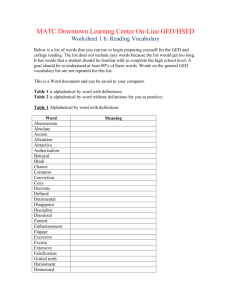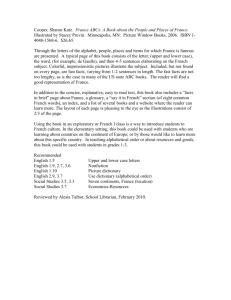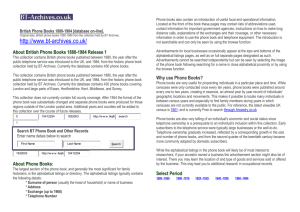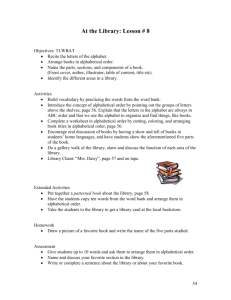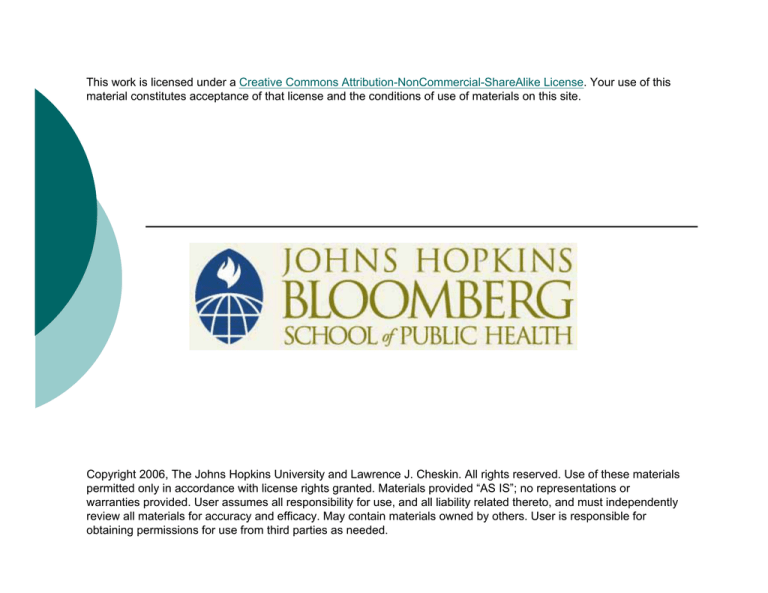
This work is licensed under a Creative Commons Attribution-NonCommercial-ShareAlike License. Your use of this
material constitutes acceptance of that license and the conditions of use of materials on this site.
Copyright 2006, The Johns Hopkins University and Lawrence J. Cheskin. All rights reserved. Use of these materials
permitted only in accordance with license rights granted. Materials provided “AS IS”; no representations or
warranties provided. User assumes all responsibility for use, and all liability related thereto, and must independently
review all materials for accuracy and efficacy. May contain materials owned by others. User is responsible for
obtaining permissions for use from third parties as needed.
Lecture 6:
Supplements and Dieting
Critical Analysis of Popular Diets
and Supplements
Instructor: Lawrence J. Cheskin, M.D.
Associate Professor, International Health
Director, Johns Hopkins Weight Management Center
Commercial Herbal Products
and Weight Loss
Lawrence J. Cheskin, M.D.
Associate Professor, International Health
Director, Johns Hopkins
Weight Management Center
Magnitude of Use
{
{
{
{
{
Potential audience: 24% men, 38%
women are trying to lose weight now
Use of herbal medicines in 1997: 5x
1990
<40% of users tell their health care
provider
$27 billion/yr out-of-pocket cost
(comparable to all traditional out-ofpocket expenditures)
Minority, ~5-10% is weight-loss
related
Potential Risks of Herbal Supplements
{
{
{
{
Direct toxicity (including allergic
reactions)
Indirect toxicity (eg, heavy metal
{Hg,As} contamination; bacterial
contamination)
Inhibition of nutrient absorption
(competitively or via blockage of
absorption)
Use in lieu of healthful
dietary/behavior changes
Indirect toxicity study (2002)
247 herbal products assayed
{
{
39 (16%) had high [heavy metals]
18 (7%) had significant bacterial
contamination
Agents in alphabetical order…
Aromatherapy
{
{
2 published studies
(Hirsch,1992,1994) show efficacy
with 2-acetyl-pyridine,
but…
-same author
-open, uncontrolled studies
No plausible mechanism (save
aversion therapy) for purported
weight control effect
Agents in alphabetical order…
Bladderwrack
{
{
{
Fucus vesiculosis
No studies published
May have thyroid-stimulating effect
Agents in alphabetical order…
Chitosan/Chitin
{
{
{
{
Chitin: from shells of crabs, shrimp, lobster
Chitosan: chitin-derived polymer of glucosamine
Binds fat in GIT, thus blocking fat absorption
Studies:
z
z
z
{
rodents lose weight
5 studies in a single Italian J: mean 3.4kg loss vs
placebo
4 wk RCT (US): no weight loss/chol/TG change vs
p
Mechanism is plausible, but probably ineffective
at reasonable doses. May block fat-soluble
vitamins.
Agents in alphabetical order…
Chromium (picolinate)
{
{
{
{
{
{
Essential micronutrient: CHO, lipid metabolism
cofactor
May enhance insulin sensitivity, decr plasma
insulin
Deficiency of Cr: raises glucose, insulin,
cholesterol, TG
Studies: most well-designed studies show no
effect; a few do
FTC recently concluded: insufficient evidence of
any effect on weight, body composition, metabolic
rate, appetite
$100 million annual sales
Agents in alphabetical order…
Conjugated linoleic acid (CLA)
{
{
{
Class of fatty acid found in meat and milk of
ruminants
inhibits LPL (increases glycerol release,
decreases fat deposition)
Studies:
z
z
z
animal: suggest anticancer and weight loss
effects, esp. decreases weight gain with
refeeding after loss
human: 1 study- suggests a mild anabolic
effect in body builders
no studies of safety, nor in obese individuals
Agents in alphabetical order…
Dihydroepiandrosterone (DHEA)
{
{
Steroid hormone whose levels decline with aging
Studies:
z
10 non-obese males, 1 month RCT vs. placebo:
decreased body fat, no decrease in weight
(lean up)
*Safety concerns regarding androgenic effects
Agents in alphabetical order…
Garcinia cambigia
{
{
{
{
{
Rind of the brindell berry
Contains a fruit acid, hydroxycitric acid
(HCA)
Found in many weight-loss products
Found to increase hepatic glycogen
synthesis, decrease food intake, decrease
weight gain
Studies:
z
z
{
4/8 RCTs: significant weight loss, but 2/4
used multiple active agents concurrently
Lab study of adult males: no effect on
metabolic rate or substrate oxidation
Safety: no significant adverse effects
reported yet
Agents in alphabetical order…
Germander
{
{
{
{
Herb of the mint family used in Europe especially,
in teas, mixtures
No published efficacy data
Known hepatic toxicity (hepatitis, jaundice)
Banned in France
Agents in alphabetical order…
Ephedra/ Ephedrine- 1
{
{
{
{
{
Can be derived from a plant whose name in
Chinese is Ma huang
Adrenergic stimulant found in many (most) OTC
weight loss products
Often combined with caffeine/guarana, another
stimulant
Studies: uncontrolled and RCTs suggest efficacy
Safety: in doubt…
Agents in alphabetical order…
Ephedra/ Ephedrine- 2
Efficacy data summary:
Rand Report:
Studies of up to 6 month duration show clinically
significant weight loss of ~2 lbs/month over
placebo
Agents in alphabetical order…
Ephedra/ Ephedrine- 3
{
{
{
Safety:
Many case reports of adverse effects,
especially CV, CNS, likely related to elevation
in BP, P
FDA proposed limiting use to low doses8mg/serving
24mg/day
1 week recommended duration of use
Proposal withdrawn after objections
February 2000
Agents in alphabetical order…
Ephedra/ Ephedrine- 4
{
{
Safety- 2
Case-control study (2003)
z
z
z
z
z
Based on reports to the National Poison
Control Center
Ephedra was associated with 64% of reported
AEs for herbal OTC products
Ephedra accounts for 1% of sales of herbals
RR = 100- 770 c/w other herbs like ginko
biloba and ginseng
Suggestive but not rigorous data: question of
denominator and reporting bias, causation,
dose
Agents in alphabetical order…
B-OH-B-methyl butyrate (HMB)
{
{
{
metabolite of the essential AA leucine
may supply a muscle cell repair precursor
Studies:
z Promotes slight increase in lean : fat
z Slight increase in strength in lean men,
women, older adults
z Not tested yet in obese for weight loss
z
No significant side effects yet reported
Agents in alphabetical order…
Psyllium
{
{
{
{
{
Derived from leafy plantain seed (soluble fiber)
Large literature on fiber and appetite
Reduces energy density of the diet and thus
promotes satiety
Insoluble and soluble fiber, plant source as well as
artificial
Studies:
z
z
{
17 lean women, Rx 20g 3hrs ac x 3d:
increased fullness, decreased fat and calorie intake
most studies in obese adults, including cross-over
studies show superiority to diet-alone
Side effect: bloating; theoretical decrease absn
Agents in alphabetical order…
Teas
{
{
{
Source: leaves of young shoots from
tea plants
Epidemiology: supports effect on
cancer, CVD, lipids (tea users vs
nonusers)
No described harm
Agents in alphabetical order…
Teas
Processing tea leaves produces 3 kinds of teas:
-
Green: produced by steaming (prevents
oxidation)
-
Oolong: produced by partial fermentation
-
Black:
produced by full fermentation
Tea’s Possible Active Ingredients
{
{
{
{
{
Tannins/ polyphenols/ catechins (such as
epigallocatechin galleate (EGCG)- inhibit
lipid peroxidation, catchol-O-methyltransferase, and fatty acid synthase)
Caffeine- inhibits phosphodiesterases, thus
may augment sympathetic (NE)
thermogenesis
Vitamin K (high levels in green tea only)
Fluoride
Theophyllines
Green Tea’s Effects
{
{
{
Antioxidant: 200x the effect of Vitamin E
mg/mg
Hypocholesterolemic effect: inhibits
intestinal cholesterol absorption and LPL
oxidation
Anticancer effect: inhibits urokinase, causes
cancer cell apoptosis
Green Tea’s Weight Effects
Human Study*:
{ Lean adults, weight maintenance diet, RC
crossover (green tea, caffeine alone,
placebo)
{ Outcome measured- energy expenditure
{ After 24 hours, green tea use raised 24 hr
EE 3.5% vs placebo, 2.8% vs caffeine
{ RQ significantly decreased on GT (fat ox
up)
{ 24 hr urinary NE up
{ Heart rate unchanged
*Dullo et al Am J Clin Nutr 1999
Green Tea’s Weight Effects
{
{
{
{
Animal studies:
Lean and obese rats- catechin EGCG
caused 50-60% decrease in EI and
acute weight loss
Effect only significant when given IP,
not PO
Mouse studies- 1. PO, 16 wk growth
slowed (EI down, decreases in liver
cholesterol, serum TG, FA)
2. PO, 11 months: decreased EI 5.6%;
beta oxidation of FAs in liver doubled
Green Tea’s Weight Effects
Summary:
Literature suggestive, but lack human weight
loss studies
No known adverse effects
Contribution of caffeine to effect may be
significant
Agents in alphabetical order…
Oolong tea (Thea sinensis)
{
{
{
{
{
Traditional anti-obesity use
Caffeine, theophylline contribute to effect
Rats: inhibits pancreatic lipase and NEinduced lipolysis in adipose tissue
No similar human studies
No known harm
Recent and current studies:
1. Effect of ephedra on RMR and appetite
{
{
{
{
{
{
30 obese volunteers
Ma huang-containing herbal supplement vs
placebo
Double-blind, cross-over design
Results: RMR by IC up 50 kcal/d vs placebo
(p=.05)
Energy intake down by 250 kcal/d vs placebo
(p<.05)
Heart rate up 6 bpm vs placebo (p<.01)
Recent and current studies:
2. Efficacy and safety of long-term ephedra
{
{
{
{
{
{
52-week, parallel group RCT: ephedracontaining, ephedra-free, placebo
supplements
50 volunteers per group
Weight loss and weight maintenance
phases
Medically monitored
Outcomes: safety, weight loss and
maintenance, biochemical and other
health parameters
Ongoing blinded trial
Conclusions & Future Needs
{
{
{
{
Arguably the only currently-available agents
with proven efficacy, at least short-term, are
ephedra, and fiber.
Herbal agents must be recognized as drugs:
natural products can be as toxic as synthetic
Unfortunately, it would be impractical and
politically unlikely that all natural, orallyconsumable ingredients could be subjected to
the degree of scientific scrutiny now only
pharmaceuticals undergo
Yet, increased power to regulate production,
marketing and the post-marketing experience
is clearly needed

